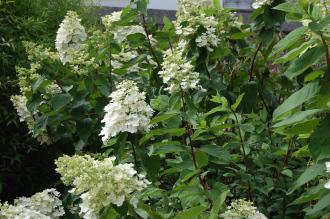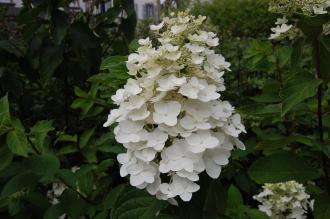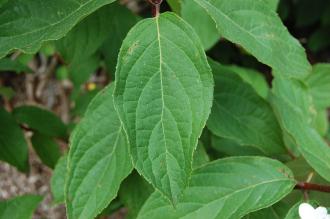
Hydrangea paniculata ‘Kyushu’ (28/08/2014, Rue de la Pointe Park, Brest, France)
Position: Full sun to dappled shade
Flowering period: Summer
Soil: Moist, well drained
Eventual Height: 3m
Eventual Spread: 3m
Hardiness: 4a, 4b, 5a, 5b, 6a, 6b, 7a, 7b, 8a, 8b, 9a
Family: Hydrangeaceae
Hydrangea paniculata ‘Kyushu’ is a deciduous shrub with an upright habit. Its mid green leaves are elliptic with mildly serrate margins, up to 14cm long and 6.5cm broad. Its white/ cream flowers appear as conical terminal panicles, up to 20cm long and is composed of sterile florets surrounded by fertile florets.

Hydrangea paniculata ‘Kyushu’ Flower (28/08/2014, Rue de la Pointe Park, Brest, France)
The species, Hydrangea paniculata, commonly known as the Panicle Hydrangea, is native to south and east China, Japan, Korea and the eastern Russian island of Sakhalin. In its native habitat it grows in open forests and thickets.
The etymological root of the binomial name Hydrangea is derived from the Greek hydor meaning ‘water’ and aggos meaning ‘jar’ which refers to the plants cusp shaped fruit. Paniculata is derived from the Latin, referring to the inflorescence taking the form of panicles.

Hydrangea paniculata ‘Kyushu’ Leaf (28/08/2014, Rue de la Pointe Park, Brest, France)
The landscape architect may find Hydrangea paniculata ‘Kyushu’ useful flowering shrub for shady location.
Ecologically, Hydrangea paniculata ‘Kyushu’ flowers are attractive to pollinating insects.
Hydrangea paniculata ‘Kyushu’ prefers moist, fertile, well-drained soils. It tolerates most pH of soil. It will not tolerate dry soils.
Hydrangea paniculata ‘Kyushu’ requires little maintenance. Pruning will produce fewer larger flowers and should be carried out in early spring.

